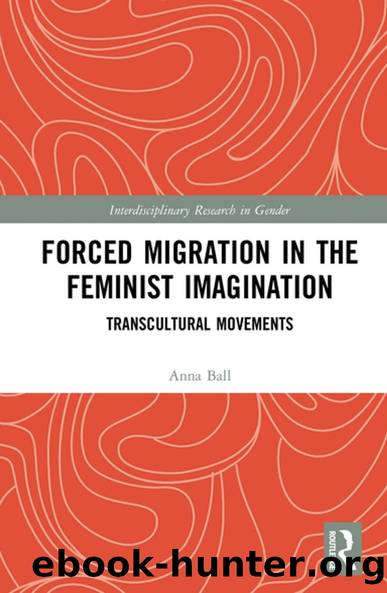Forced Migration in the Feminist Imagination by Anna Ball

Author:Anna Ball [Ball, Anna]
Language: eng
Format: epub
Tags: Social Science, Feminism & Feminist Theory, Women's Studies
ISBN: 9781000459173
Google: DaxCEAAAQBAJ
Barnesnoble:
Publisher: Routledge
Published: 2021-09-21T02:57:45+00:00
4 Sounding out dissent Learning to listen to women in detention through sonic creativities
DOI: 10.4324/9780429325403-4
It is Spring in the Bedfordshire countryside and something is moving. A line of people is beating a path through the fields in search of a discordant structure tucked deep amidst the crops of rapeseed. When they find it, they pause: the perimeter is too high to scale, but that is not what they are here to do. Instead, they turn their backs on the fences and beat the metal panels with the flats of their feet; rattle the struts in their hands. They pull drums, pots, pans, cowbells from their bags and beat and shake them until the air all about them is a vast dissonance of clanging, juddering, jangling, and crashing â a wall of noise rising high above the fences. And before long, hands begin to reply to their call. Windows open and arms wave home-made banners. Voices crackle through megaphones projecting phone calls from those inside the building: âI never committed a crime, never did anything wrong. I need freedom, pleaseâ; âI miss my son, I miss my husband. My son is nine years old⦠freedomâ.1
Figure 4.1 Protestors create a âwall of soundâ around Yarlâs Wood, Bedfordshire. Photograph by and courtesy of Chris Bethell.
These voices do not bring the walls crumbling to the ground. But across the airwaves of these most verdant and secretively governmentalised of spaces, it is nevertheless possible to sense a distinctive movement at play â one based, certainly, in a demand for social justice, but also in a complicated reciprocity produced through the process of voicing and listening: in the passage of sound as a dissident movement in itself.
This 2017 protest, led by the umbrella organiser Movement for Justice but displaying protest stances heavily weighted towards feminist and LGBTQ+ activisms,2 was one of many to be staged in the past decade outside Yarlâs Wood: a predominantly female-populated U.K. âImmigration Removal Centreâ (IRC) for around 400 asylum seekers and immigrants facing deportation or awaiting confirmation of their immigration claims.3 In itself, this protest presents a powerful articulation of the grassroots opposition that has grown concurrently with the increased governmental popularity of immigration detention as a bio/necropolitical mechanism over the course of the twenty-first century.4 A significant strand of this opposition has proven feminocentric, sparked in outrage not simply at the traumatisation and radical dehumanisation of already-vulnerable people that this system engenders but also at the generally unrecognised structures of interlocking disenfranchisement that place women in especially precarious and painful positions within it.5 Gender-conscious reports produced in response to immigration detention systems in the U.S., Australia, and the U.K. have identified commonalities in gender-specific forms of trauma and oppression exercised against women â notably, lack of attentiveness to female health needs within a male-dominated system, a dearth of gender sensitivity in the supervision of women within mixed facilities, and the prevalence of sexual coercion, abuse, and violence towards women, including by guards â a phenomenon that women have little opportunity to report without fear of repercussion.
Download
This site does not store any files on its server. We only index and link to content provided by other sites. Please contact the content providers to delete copyright contents if any and email us, we'll remove relevant links or contents immediately.
On the Front Line with the Women Who Fight Back by Stacey Dooley(4307)
The Lonely City by Olivia Laing(4112)
The Rules Do Not Apply by Ariel Levy(3897)
Bluets by Maggie Nelson(3705)
The Confidence Code by Katty Kay(3560)
Three Women by Lisa Taddeo(2916)
Inferior by Angela Saini(2829)
A Woman Makes a Plan by Maye Musk(2824)
Pledged by Alexandra Robbins(2788)
Not a Diet Book by James Smith(2715)
Confessions of a Video Vixen by Karrine Steffans(2668)
Nice Girls Don't Get the Corner Office by Lois P. Frankel(2589)
Wild Words from Wild Women by Stephens Autumn(2584)
Brave by Rose McGowan(2497)
The Girl in the Spider's Web: A Lisbeth Salander novel, continuing Stieg Larsson's Millennium Series by Lagercrantz David(2379)
The Clitoral Truth: The Secret World at Your Fingertips by Rebecca Chalker(2240)
Why I Am Not a Feminist by Jessa Crispin(2235)
Women & Power by Mary Beard(2219)
Women on Top by Nancy Friday(2118)
